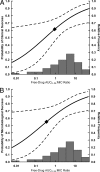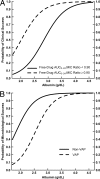Pharmacological and patient-specific response determinants in patients with hospital-acquired pneumonia treated with tigecycline
- PMID: 22143524
- PMCID: PMC3264202
- DOI: 10.1128/AAC.01615-10
Pharmacological and patient-specific response determinants in patients with hospital-acquired pneumonia treated with tigecycline
Abstract
Pharmacokinetic and clinical data from tigecycline-treated patients with hospital-acquired pneumonia (HAP) who were enrolled in a phase 3 clinical trial were integrated in order to evaluate pharmacokinetic-pharmacodynamic (PK-PD) relationships for efficacy. Univariable and multivariable analyses were conducted to identify factors associated with clinical and microbiological responses, based on data from 61 evaluable HAP patients who received tigecycline intravenously as a 100-mg loading dose followed by 50 mg every 12 h for a minimum of 7 days and for whom there were adequate clinical, pharmacokinetic, and response data. The final multivariable logistic regression model for clinical response contained albumin and the ratio of the free-drug area under the concentration-time curve from 0 to 24 h (fAUC(0-24)) to the MIC (fAUC(0-24):MIC ratio). The odds of clinical success were 13.0 times higher for every 1-g/dl increase in albumin (P < 0.001) and 8.42 times higher for patients with fAUC(0-24):MIC ratios of ≥0.9 compared to patients with fAUC(0-24):MIC ratios of <0.9 (P = 0.008). Average model-estimated probabilities of clinical success for the albumin/fAUC(0-24):MIC ratio combinations of <2.6/<0.9, <2.6/≥0.9, ≥2.6/<0.9, and ≥2.6/≥0.9 were 0.21, 0.57, 0.64, and 0.93, respectively. For microbiological response, the final model contained albumin and ventilator-associated pneumonia (VAP) status. The odds of microbiological success were 21.0 times higher for every 1-g/dl increase in albumin (P < 0.001) and 8.59 times higher for patients without VAP compared to those with VAP (P = 0.003). Among the remaining variables evaluated, the MIC had the greatest statistical significance, an observation which was not surprising given the differences in MIC distributions between VAP and non-VAP patients (MIC(50)and MIC(90) values of 0.5 and 0.25 mg/liter versus 16 and 1 mg/liter for VAP versus non-VAP patients, respectively; P = 0.006). These findings demonstrated the impact of pharmacological and patient-specific factors on the clinical and microbiological responses.
Figures



Similar articles
-
Pharmacokinetics-pharmacodynamics of tigecycline in patients with community-acquired pneumonia.Antimicrob Agents Chemother. 2012 Jan;56(1):130-6. doi: 10.1128/AAC.00277-10. Epub 2011 Oct 3. Antimicrob Agents Chemother. 2012. PMID: 21968360 Free PMC article. Clinical Trial.
-
Pharmacodynamics of tigecycline against phenotypically diverse Staphylococcus aureus isolates in a murine thigh model.Antimicrob Agents Chemother. 2009 Mar;53(3):1165-9. doi: 10.1128/AAC.00647-08. Epub 2008 Dec 29. Antimicrob Agents Chemother. 2009. PMID: 19114676 Free PMC article.
-
Exposure-response analyses of tigecycline efficacy in patients with complicated intra-abdominal infections.Antimicrob Agents Chemother. 2008 Jan;52(1):204-10. doi: 10.1128/AAC.00813-07. Epub 2007 Oct 22. Antimicrob Agents Chemother. 2008. PMID: 17954694 Free PMC article. Clinical Trial.
-
Pharmacokinetic and pharmacodynamics evaluation of ceftobiprole medocaril for the treatment of hospital-acquired pneumonia.Expert Opin Drug Metab Toxicol. 2013 Jun;9(6):789-99. doi: 10.1517/17425255.2013.788150. Epub 2013 Apr 17. Expert Opin Drug Metab Toxicol. 2013. PMID: 23590397 Review.
-
Tigecycline for the treatment of patients with community-acquired pneumonia requiring hospitalization.Expert Rev Anti Infect Ther. 2009 Oct;7(8):913-23. doi: 10.1586/eri.09.73. Expert Rev Anti Infect Ther. 2009. PMID: 19803699 Review.
Cited by
-
Pharmacodynamic and pharmacokinetic considerations in the treatment of critically Ill patients infected with carbapenem-resistant Enterobacteriaceae.Virulence. 2017 May 19;8(4):440-452. doi: 10.1080/21505594.2016.1221021. Epub 2016 Aug 9. Virulence. 2017. PMID: 27589330 Free PMC article. Review.
-
In Vivo Pharmacodynamic Evaluation of Omadacycline against Staphylococcus aureus in the Neutropenic Mouse Pneumonia Model.Antimicrob Agents Chemother. 2020 Jan 27;64(2):e02058-19. doi: 10.1128/AAC.02058-19. Print 2020 Jan 27. Antimicrob Agents Chemother. 2020. PMID: 31712210 Free PMC article.
-
Influence of severity of infection on the effect of appropriate antimicrobial therapy for Acinetobacter baumannii bacteremic pneumonia.Antimicrob Resist Infect Control. 2020 Sep 29;9(1):160. doi: 10.1186/s13756-020-00824-4. Antimicrob Resist Infect Control. 2020. PMID: 32993810 Free PMC article.
-
Frequentist and Bayesian pharmacometric-based approaches to facilitate critically needed new antibiotic development: overcoming lies, damn lies, and statistics.Antimicrob Agents Chemother. 2012 Mar;56(3):1466-70. doi: 10.1128/AAC.01743-10. Epub 2011 Dec 12. Antimicrob Agents Chemother. 2012. PMID: 22155834 Free PMC article. Clinical Trial.
-
Management of Adults With Hospital-acquired and Ventilator-associated Pneumonia: 2016 Clinical Practice Guidelines by the Infectious Diseases Society of America and the American Thoracic Society.Clin Infect Dis. 2016 Sep 1;63(5):e61-e111. doi: 10.1093/cid/ciw353. Epub 2016 Jul 14. Clin Infect Dis. 2016. PMID: 27418577 Free PMC article.
References
-
- Albert A, Anderson JA. 1984. On the existence of maximum-likelihood estimates in logistic regression models. Biometrika 77:1–10
-
- Al-Muhairi SA, Zoubeidi TA, Ellis ME, Safa WF, Joseph J. 2006. Risk factors predicting outcome in patients with pneumonia in Al-Ain, United Arab Emirates. Saudi Med. J. 27:1044–1048 - PubMed
-
- Ambrose PG, Bhavnani SM, Ellis-Grosse EJ, Drusano GL. 2010. Pharmacokinetic-pharmacodynamic considerations in the design of hospital-acquired or ventilator-associated bacterial pneumonia studies: look before you leap! Clin. Infect. Dis. 51(Supp. 1):S103–S110 - PubMed
-
- Ambrose PG. 2008. Use of pharmacokinetics and pharmacodynamics in a failure analysis of community-acquired pneumonia: implications for future clinical trial study design. Clin. Infect. Dis. 47:S225–S231 - PubMed
-
- . 2009. FDA asks for more information before sanctioning J &J PRD's drug for hospital-acquired pneumonia. Genet. Engin. Biotechnol. News http://www.genengnews.com/news/bnitem.aspx?name=40760576&source=genwire
Publication types
MeSH terms
Substances
LinkOut - more resources
Full Text Sources
Other Literature Sources
Medical

